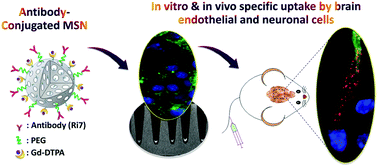Antibody-conjugated mesoporous silica nanoparticles for brain microvessel endothelial cell targeting†
Abstract
Brain microvessel endothelial cells (BMECs) are the main structural and dynamic components of the blood–brain barrier (BBB), preventing the majority of drugs from reaching the brain. Since BMECs are involved in a wide range of central nervous system diseases, the development of nanocarriers that trigger receptor-mediated uptake in these cells has been suggested as a promising approach to an increased drug delivery to the brain. Here, we report the size and the bioconjugation effects of antibody-conjugated mesoporous silica nanoparticles (MSNs) on in vitro and in vivo targeting ability to BMECs. For this, Ri7 antibody was conjugated to MSNs of two different sizes (50 nm and 160 nm in diameter) through a polyethylene glycol (PEG) linker. The particles were also functionalized with a MRI contrast agent (gadolinium chelate) and with a fluorescent label. The functionalized MSN suspensions showed good colloidal stability. The Ri7 antibody immobilized on the MSN surface maintained its high specific activity and high binding affinity, as demonstrated in vitro. Cells incubated with gadolinium-chelated Ri7-MSNs showed a significant MRI positive contrast enhancement, highlighting the potential of such nanoparticles for theranostic applications. To measure the uptake and affinity of Ri7-MSNs to brain endothelial and neuronal cells, cell uptake studies were performed and a quantitative cellular assay was developed. The results revealed that endocytosis of nanoparticles is mediated by transferrin receptors and that Ri7-MSN cellular uptake is size- and time-dependent. A highest specific uptake was found with 50 nm Ri7-MSNs. Upon intravenous injection, 50 nm Ri7-MSNs were specifically accumulated in BMECs, suggesting the strong potential of antibody-coated nanoparticles for targeting BMECs in vivo. These findings open the door to therapeutic targeting of BMECs, enabling potential therapeutic drug delivery to the brain.



 Please wait while we load your content...
Please wait while we load your content...